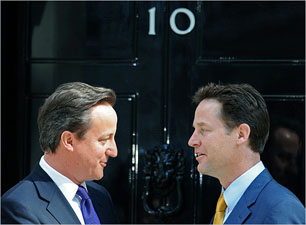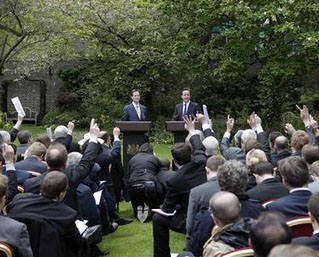What does historic British election and new coalition mean for Canada in 2010?
May 11th, 2010 | By L. Frank Bunting | Category: In Brief
Prime Minister David Cameron (l) and Deputy Prime Minister Nick Clegg, outside 10 Downing Street on Wednesday 12 May 2010. Carl De Souza/Agence France-Presse – Getty Images.
One hundred years ago today, more or less, was apparently also a historic time in the United Kingdom. On May 6, 1910 (100 years from the date of the British election last week) George V had become King on the death of his father, Edward VII. Meanwhile an election that took place from 15 January to 20 February 1910 had returned another “hung parliament.”
The Liberals led by H.H. Asquith won 274 seats. The Conservatives (and so-called “Liberal Unionists”) under Arthur Balfour had 272 seats. The still quite embryonic Labour Party of the day had 40 seats. And something known as the Irish Parliamentary party (which has now largely disappeared into the independent Irish republic) had 71 seats. A subsequent second election, from 3—19 December 1910, produced very similar results. Asquith formed a Liberal government with the support of the Irish party.
Back across the Atlantic Ocean, on May 11, 1910, Wilfrid Laurier was still Liberal prime minister of Canada (having won 133 seats in the October 26, 1908 federal election, compared to 85 seats for the Conservatives under Robert Borden). But no one resident in what was then widely known as Tory Toronto followed either of the 1910 British elections, or the death of Edward VII, on BBC TV.
This afternoon, Toronto time – and five hours later, in the not-quite-dark evening, Greenwich mean time – I watched the changing of the guard at Buckingham Palace on BBC World, from a Toronto that voted no Tories at all into office in 2008. First there was the resignation of Gordon Brown as UK prime minister, followed by the appointment of his successor David Cameron, followed by a short, crisp statement from Mr. Cameron in front of 10 Downing Street: “Her Majesty the Queen has asked me to form a new Government and I have accepted … I aim to form a proper and full coalition between the Conservatives and the Liberal Democrats.”
Like others who contribute to this site, I would like to see the end of the last all too quaint and irrational symbolic vestiges of the British monarchy in Canada, at the end of the reign of Queen Elizabeth II. Like most emerging Canadian “republicans,” however, I also strongly support our continuing British-style or Westminister parliamentary democracy (on the model, eg, of such other early 21st century parliamentary democratic republics as India and Ireland). And I altogether agreed with this past Saturday’s Toronto Star editorial: “The British leaders’ instinct to reach out and make something positive of the shambles they were handed shows a political maturity that Canadians may well envy. There was genuine concern Friday about ‘the good of the country’ and ‘strong, stable government’.”

Prime Minister David Cameron (r) and Deputy Prime Minister Nick Clegg hold their first joint news conference in the garden of 10 Downing Street, 12 May 2010. REUTERS/Christopher Furlong/POOL.
Ferdinand Mount, both a former head of Margaret Thatcher’s policy unit and a former editor of the Times Literary Supplement, makes clear how so many of the ills of our Canadian federal political system today are present as well in what earlier generations called the Mother of Parliaments, in a recent issue of the London Review of Books. Yet, as Mount also nicely summarizes things, the “challenge now is not so much to train power to tell the truth (an uphill task, to put it mildly) as to make sure that it lies in more places.” With the new “proper and full coalition between the Conservatives and the Liberal Democrats” that David Cameron and Nick Clegg have now begun, to the surprise of many, the original Westminster parliamentary democracy actually seems to have made some kind of start on meeting this challenge. We ought to be especially inspired by this example in Canada, because we are still light years away from any such thing.

